Edible Carrageenan Films Reinforced with Starch and Nanocellulose: Development and Characterization
Abstract
:1. Introduction
2. Materials and Methods
2.1. Extraction of Polysaccharides
2.2. Materials
2.3. Film Preparation
2.4. Investigation of Films
2.4.1. Fourier-Transform Infrared Spectroscopy (FTIR)
2.4.2. Scanning Electron Microscopy (SEM)
2.4.3. Atomic Force Microscopy (AFM)
2.4.4. Contact Angle Measurements
2.4.5. Mechanical Properties
2.4.6. Thermogravimetric Analysis (TGA)
2.4.7. Water Vapor Permeability (WVP)
2.4.8. Oil Permeability (OP)
2.4.9. Moisture Absorption (MA)
2.4.10. Solubility in Water
2.4.11. Density Measurement
2.4.12. Film Light Transmission
2.4.13. Statistical Analysis
3. Results and Discussion
3.1. Optimization of Film Composition
3.2. Film Structure Investigation
3.3. Film Physicochemical Properties Investigation
4. Conclusions
Author Contributions
Funding
Institutional Review Board Statement
Informed Consent Statement
Data Availability Statement
Acknowledgments
Conflicts of Interest
References
- Calicioglu, O.; Flammini, A.; Bracco, S.; Bellù, L.; Sims, R. The Future Challenges of Food and Agriculture: An Integrated Analysis of Trends and Solutions. Sustainability 2019, 11, 222. [Google Scholar] [CrossRef]
- Ren, H.; Li, S.; Gao, M.; Xing, X.; Tian, Y.; Ling, Z.; Yang, W.; Pan, L.; Fan, W.; Zheng, Y. Preparation and Characterization of Microcrystalline Cellulose/Polylactic Acid Biocomposite Films and Its Application in Lanzhou Lily (Lilium davidii var. unicolor) Bulbs Preservation. Sustainability 2023, 15, 13770. [Google Scholar] [CrossRef]
- Marsh, K.; Bugusu, B. Food Packaging? Roles, Materials, and Environmental Issues. J. Food Sci. 2007, 72, R39–R55. [Google Scholar] [CrossRef]
- Food Process Engineering and Technology; Elsevier: Amsterdam, The Netherlands, 2013; ISBN 9780124159235.
- Zinina, O.; Merenkova, S.; Galimov, D. Development of Biodegradable Alginate-Based Films with Bioactive Properties and Optimal Structural Characteristics with Incorporation of Protein Hydrolysates. Sustainability 2023, 15, 15086. [Google Scholar] [CrossRef]
- Kontogianni, V.G.; Kosma, I.; Mataragas, M.; Pappa, E.; Badeka, A.V.; Bosnea, L. Innovative Intelligent Cheese Packaging with Whey Protein-Based Edible Films Containing Spirulina. Sustainability 2023, 15, 13909. [Google Scholar] [CrossRef]
- Moshood, T.D.; Nawanir, G.; Mahmud, F.; Mohamad, F.; Ahmad, M.H.; AbdulGhani, A. Sustainability of biodegradable plastics: New problem or solution to solve the global plastic pollution? Curr. Res. Green Sustain. Chem. 2022, 5, 100273. [Google Scholar] [CrossRef]
- Wang, C.; Gong, C.; Qin, Y.; Hu, Y.; Jiao, A.; Jin, Z.; Qiu, C.; Wang, J. Bioactive and functional biodegradable packaging films reinforced with nanoparticles. J. Food Eng. 2022, 312, 110752. [Google Scholar] [CrossRef]
- Cristofoli, N.L.; Lima, A.R.; Tchonkouang, R.D.N.; Quintino, A.C.; Vieira, M.C. Advances in the Food Packaging Production from Agri-Food Waste and By-Products: Market Trends for a Sustainable Development. Sustainability 2023, 15, 6153. [Google Scholar] [CrossRef]
- Sedayu, B.B.; Cran, M.J.; Bigger, S.W. A Review of Property Enhancement Techniques for Carrageenan-based Films and Coatings. Carbohydr. Polym. 2019, 216, 287–302. [Google Scholar] [CrossRef]
- Onyeaka, H.; Obileke, K.; Makaka, G.; Nwokolo, N. Current Research and Applications of Starch-Based Biodegradable Films for Food Packaging. Polymers 2022, 14, 1126. [Google Scholar] [CrossRef]
- Tarique, J.; Sapuan, S.M.; Khalina, A.; Sherwani, S.F.K.; Yusuf, J.; Ilyas, R.A. Recent developments in sustainable arrowroot (Maranta arundinacea Linn) starch biopolymers, fibres, biopolymer composites and their potential industrial applications: A review. J. Mater. Res. Technol. 2021, 13, 1191–1219. [Google Scholar] [CrossRef]
- Winarti, C.; Widaningrum; Surono, I.S.; Uswah, M. Effect of Acid And Hydrolysis Duration on The Characteristics of Arrowroot and Taro Starch Nanoparticles. IOP Conf. Ser. Earth Environ. Sci. 2019, 309, 012039. [Google Scholar] [CrossRef]
- Tharanathan, R. Biodegradable films and composite coatings: Past, present and future. Trends Food Sci. Technol. 2003, 14, 71–78. [Google Scholar] [CrossRef]
- Sulaiman, M.; Rabbani, F.A.; Iqbal, T.; Riaz, F.; Raashid, M.; Ullah, N.; Yasin, S.; Fouad, Y.; Abbas, M.M.; Kalam, M.A. Development and Characterization of Polymeric Composites Reinforced with Lignocellulosic Wastes for Packaging Applications. Sustainability 2023, 15, 10161. [Google Scholar] [CrossRef]
- Wahjuningsih, S.B.; Rohadi; Susanti, S.; Setyanto, H.Y. The Effect of K-Carrageenan Addition to the Characteristics of Jicama Starch-Based Edible Coating and Its Potential Application on The Grapevine. Int. J. Adv. Sci. Eng. Inf. Technol. 2019, 9, 405. [Google Scholar] [CrossRef]
- Thakur, R.; Saberi, B.; Pristijono, P.; Golding, J.; Stathopoulos, C.; Scarlett, C.; Bowyer, M.; Vuong, Q. Characterization of rice starch-ι-carrageenan biodegradable edible film. Effect of stearic acid on the film properties. Int. J. Biol. Macromol. 2016, 93, 952–960. [Google Scholar] [CrossRef]
- Thakur, R.; Pristijono, P.; Golding, J.B.; Stathopoulos, C.E.; Scarlett, C.; Bowyer, M.; Singh, S.P.; Vuong, Q.V. Effect of starch physiology, gelatinization, and retrogradation on the attributes of rice starch-ι-carrageenan film. Starch—Stärke 2018, 70, 1700099. [Google Scholar] [CrossRef]
- Thakur, R.; Pristijono, P.; Golding, J.B.; Stathopoulos, C.E.; Scarlett, C.J.; Bowyer, M.; Singh, S.P.; Vuong, Q.V. Amylose-lipid complex as a measure of variations in physical, mechanical and barrier attributes of rice starch- ι -carrageenan biodegradable edible film. Food Packag. Shelf Life 2017, 14, 108–115. [Google Scholar] [CrossRef]
- Thakur, R.; Pristijono, P.; Golding, J.B.; Stathopoulos, C.E.; Scarlett, C.J.; Bowyer, M.; Singh, S.P.; Vuong, Q.V. Development and application of rice starch based edible coating to improve the postharvest storage potential and quality of plum fruit (Prunus salicina). Sci. Hortic. 2018, 237, 59–66. [Google Scholar] [CrossRef]
- Ahankari, S.S.; Subhedar, A.R.; Bhadauria, S.S.; Dufresne, A. Nanocellulose in food packaging: A review. Carbohydr. Polym. 2021, 255, 117479. [Google Scholar] [CrossRef]
- Cherian, R.M.; Varghese, R.T.; Antony, T.; Malhotra, A.; Kargarzadeh, H.; Chauhan, S.R.; Chauhan, A.; Chirayil, C.J.; Thomas, S. Non-cytotoxic, highly functionalized cellulose nanocrystals with high crystallinity and thermal stability derived from a novel agromass of Elettaria cardamomum, using a soft and benign mild oxalic acid hydrolysis. Int. J. Biol. Macromol. 2023, 253, 126571. [Google Scholar] [CrossRef] [PubMed]
- Pasquini, D.; de Morais, L.C.; Costa, P.E. Nanofibers for Environmental Remediation. In Nanotechnology for Environmental Remediation; Wiley: Hoboken, NJ, USA, 2022; pp. 301–321. [Google Scholar]
- Thakur, V.; Guleria, A.; Kumar, S.; Sharma, S.; Singh, K. Recent advances in nanocellulose processing, functionalization and applications: A review. Mater. Adv. 2021, 2, 1872–1895. [Google Scholar] [CrossRef]
- Dufresne, A. Nanocellulose; DE GRUYTER: Berlin, Germany, 2012; ISBN 978-3-11-025456-3. [Google Scholar]
- Kaushik, M.; Moores, A. Review: Nanocelluloses as versatile supports for metal nanoparticles and their applications in catalysis. Green Chem. 2016, 18, 622–637. [Google Scholar] [CrossRef]
- Kallel, F.; Bettaieb, F.; Khiari, R.; García, A.; Bras, J.; Chaabouni, S.E. Isolation and structural characterization of cellulose nanocrystals extracted from garlic straw residues. Ind. Crops Prod. 2016, 87, 287–296. [Google Scholar] [CrossRef]
- Alzate-Arbeláez, A.F.; Dorta, E.; López-Alarcón, C.; Cortés, F.B.; Rojano, B.A. Immobilization of Andean berry (Vaccinium meridionale) polyphenols on nanocellulose isolated from banana residues: A natural food additive with antioxidant properties. Food Chem. 2019, 294, 503–517. [Google Scholar] [CrossRef] [PubMed]
- Widiarto, S.; Yuwono, S.D.; Rochliadi, A.; Arcana, I.M. Preparation and Characterization of Cellulose and Nanocellulose from Agro-industrial Waste—Cassava Peel. IOP Conf. Ser. Mater. Sci. Eng. 2017, 176, 012052. [Google Scholar] [CrossRef]
- Mat Zain, N.F. Preparation and Characterization of Cellulose and Nanocellulose From Pomelo (Citrus grandis) Albedo. J. Nutr. Food Sci. 2014, 5, 334. [Google Scholar] [CrossRef]
- Tibolla, H.; Pelissari, F.M.; Rodrigues, M.I.; Menegalli, F.C. Cellulose nanofibers produced from banana peel by enzymatic treatment: Study of process conditions. Ind. Crops Prod. 2017, 95, 664–674. [Google Scholar] [CrossRef]
- Jati, I.R.A.P.; Setijawaty, E.; Utomo, A.R.; Darmoatmodjo, L.M.Y.D. The Application of Aloe vera Gel as Coating Agent to Maintain the Quality of Tomatoes during Storage. Coatings 2022, 12, 1480. [Google Scholar] [CrossRef]
- Sánchez, M.; González-Burgos, E.; Iglesias, I.; Gómez-Serranillos, M.P. Pharmacological Update Properties of Aloe Vera and its Major Active Constituents. Molecules 2020, 25, 1324. [Google Scholar] [CrossRef]
- Nicolau-Lapeña, I.; Colàs-Medà, P.; Alegre, I.; Aguiló-Aguayo, I.; Muranyi, P.; Viñas, I. Aloe vera gel: An update on its use as a functional edible coating to preserve fruits and vegetables. Prog. Org. Coatings 2021, 151, 106007. [Google Scholar] [CrossRef]
- Misir, J.; Brishti, F.H.; Hoque, M.M. Aloe vera gel as a Novel Edible Coating for Fresh Fruits: A Review. Am. J. Food Sci. Technol. 2014, 2, 93–97. [Google Scholar] [CrossRef]
- Ortega-Toro, R.; López-Córdoba, A.; Avalos-Belmontes, F. Epoxidised sesame oil as a biobased coupling agent and plasticiser in polylactic acid/thermoplastic yam starch blends. Heliyon 2021, 7, e06176. [Google Scholar] [CrossRef]
- Vieira, M.G.A.; da Silva, M.A.; dos Santos, L.O.; Beppu, M.M. Natural-based plasticizers and biopolymer films: A review. Eur. Polym. J. 2011, 47, 254–263. [Google Scholar] [CrossRef]
- Tarique, J.; Sapuan, S.M.; Khalina, A. Effect of glycerol plasticizer loading on the physical, mechanical, thermal, and barrier properties of arrowroot (Maranta arundinacea) starch biopolymers. Sci. Rep. 2021, 11, 13900. [Google Scholar] [CrossRef]
- Nogueira, G.F.; Fakhouri, F.M.; de Oliveira, R.A. Extraction and characterization of arrowroot (Maranta arundinaceae L.) starch and its application in edible films. Carbohydr. Polym. 2018, 186, 64–72. [Google Scholar] [CrossRef] [PubMed]
- Kailas, T.; Kersen, P.; Martin, G.; Truus, K.; Tuvikene, R.; Vaher, M. Extraction and quantification of hybrid carrageenans from the biomass of the red algae Furcellaria lumbricalis and Coccotylus truncatus. Proc. Est. Acad. Sci. Chem. 2006, 55, 40. [Google Scholar] [CrossRef]
- Chawalitsakunchai, W.; Dittanet, P.; Loykulnunt, S.; Tanpichai, S.; Prapainainar, P. Extraction of nanocellulose from pineapple leaves by acid-hydrolysis and pressurized acid hydrolysis for reinforcement in natural rubber composites. IOP Conf. Ser. Mater. Sci. Eng. 2019, 526, 012019. [Google Scholar] [CrossRef]
- Cherian, B.M.; Leão, A.L.; de Souza, S.F.; Thomas, S.; Pothan, L.A.; Kottaisamy, M. Isolation of nanocellulose from pineapple leaf fibres by steam explosion. Carbohydr. Polym. 2010, 81, 720–725. [Google Scholar] [CrossRef]
- Dmitrenko, M.; Liamin, V.; Kuzminova, A.; Mazur, A.; Lahderanta, E.; Ermakov, S.; Penkova, A. Novel Mixed Matrix Sodium Alginate–Fullerenol Membranes: Development, Characterization, and Study in Pervaporation Dehydration of Isopropanol. Polymers 2020, 12, 864. [Google Scholar] [CrossRef]
- Liu, Y.; Olewski, T.; Véchot, L.N. Modeling of a cryogenic liquid pool boiling by CFD simulation. J. Loss Prev. Process Ind. 2015, 35, 125–134. [Google Scholar] [CrossRef]
- Xu, L.C.; Siedlecki, C.A. Atomic force microscopy. Compr. Biomater. 2011, 3, 23–35. [Google Scholar] [CrossRef]
- Gribanova, E.V.; Larionov, M.I. Application of contact angle dependence on ph for estimation of acid-base properties of oxide surfaces. Vestn. Saint-Petersbg. Univ. Ser. 4. Physics. Chem. 2014, 1, 401–407. [Google Scholar]
- ASTM D638-14:2014; Standard Test Method for Tensile Properties of Plastics. ASTM International: West Conshohocken, PA, USA, 2014.
- ISO 527-2:2012; Plastics-Determination of Tensile Properties-Part 2: Test Conditions for Moulding and Extrusion Plastics. International Organization for Standardization: Geneva, Switzerland, 2012.
- A. E. 95; Standard Test Methods for Water Vapor Transmission of Materials. ASTM International: West Conshohocken, PA, USA, 1995.
- Nguyen, H.N.; Dinh, K.D.; Vu, L.T.K. Carboxymethyl Cellulose /Aloe Vera Gel Edible Films for Food Preservation. In Proceedings of the 2020 5th International Conference on Green Technology and Sustainable Development (GTSD), Ho Chi Minh City, Vietnam, 27–28 November 2020; pp. 203–208. [Google Scholar] [CrossRef]
- Wang, L.Z.; Liu, L.; Holmes, J.; Kerry, J.F.; Kerry, J.P. Assessment of film-forming potential and properties of protein and polysaccharide-based biopolymer films. Int. J. Food Sci. Technol. 2007, 42, 1128–1138. [Google Scholar] [CrossRef]
- Anglès, M.N.; Dufresne, A. Plasticized Starch/Tunicin Whiskers Nanocomposite Materials. 2. Mechanical Behavior. Macromolecules 2001, 34, 2921–2931. [Google Scholar] [CrossRef]
- Bierhalz, A.C.K.; da Silva, M.A.; Kieckbusch, T.G. Natamycin release from alginate/pectin films for food packaging applications. J. Food Eng. 2012, 110, 18–25. [Google Scholar] [CrossRef]
- Dmitrenko, M.; Kuzminova, A.; Zolotarev, A.; Liamin, V.; Markelov, D.; Semenov, K.; Plisko, T.; Bildyukevich, A.; Penkova, A. Novel pervaporation membranes based on hydroxyethyl cellulose/polyvinyl alcohol modified with fullerene derivatives for enhanced isopropanol dehydration. J. Mater. Res. 2021, 36, 4986–5001. [Google Scholar] [CrossRef]
- Ma, X.; Zhuang, X.; Ma, G. Transparent Windows on Food Packaging Do Not Always Capture Attention and Increase Purchase Intention. Front. Psychol. 2020, 11, 593690. [Google Scholar] [CrossRef]
- Guzman-Puyol, S.; Benítez, J.J.; Heredia-Guerrero, J.A. Transparency of polymeric food packaging materials. Food Res. Int. 2022, 161, 111792. [Google Scholar] [CrossRef]
- Martins, J.T.; Cerqueira, M.A.; Bourbon, A.I.; Pinheiro, A.C.; Souza, B.W.S.; Vicente, A.A. Synergistic effects between κ-carrageenan and locust bean gum on physicochemical properties of edible films made thereof. Food Hydrocoll. 2012, 29, 280–289. [Google Scholar] [CrossRef]
- Subando, T.R. Optimization and Characterization of Arrowroot Porous Starch Using Thermostable α-amylase by Response Surface Methodology. 2023, pp. 1–25. Available online: https://www.researchgate.net/publication/367550606_Optimization_and_Characterization_of_Arrowroot_Porous_Starch_Using_Thermostable_a-amylase_by_Response_Surface_Methodology (accessed on 30 January 2023).
- Zhao, A.-Q.; Yu, L.; Yang, M.; Wang, C.-J.; Wang, M.-M.; Bai, X. Effects of the combination of freeze-thawing and enzymatic hydrolysis on the microstructure and physicochemical properties of porous corn starch. Food Hydrocoll. 2018, 83, 465–472. [Google Scholar] [CrossRef]
- Damian, K.B.B.T.; Bermundo, K.A.C.; Macatol, Y.B.L.; Marino, G.P.C.; Aquino, R.R. Fabrication and Characterization of Biocomposite Membranes from Polycaprolactone and Native Arrowroot (Maranta arundinacea L.) Extracted Starch. Mater. Sci. Forum 2020, 998, 163–169. [Google Scholar] [CrossRef]
- Chirayil, C.J.; Joy, J.; Mathew, L.; Mozetic, M.; Koetz, J.; Thomas, S. Isolation and characterization of cellulose nanofibrils from Helicteres isora plant. Ind. Crops Prod. 2014, 59, 27–34. [Google Scholar] [CrossRef]
- Mandal, A.; Chakrabarty, D. Isolation of nanocellulose from waste sugarcane bagasse (SCB) and its characterization. Carbohydr. Polym. 2011, 86, 1291–1299. [Google Scholar] [CrossRef]
- Wulandari, W.T.; Rochliadi, A.; Arcana, I.M. Nanocellulose prepared by acid hydrolysis of isolated cellulose from sugarcane bagasse. IOP Conf. Ser. Mater. Sci. Eng. 2016, 107, 012045. [Google Scholar] [CrossRef]
- Pérez, C.D.; Flores, S.K.; Marangoni, A.G.; Gerschenson, L.N.; Rojas, A.M. Development of a High Methoxyl Pectin Edible Film for Retention of l-(+)-Ascorbic Acid. J. Agric. Food Chem. 2009, 57, 6844–6855. [Google Scholar] [CrossRef]
- Basiak, E.; Lenart, A.; Debeaufort, F. How Glycerol and Water Contents Affect the Structural and Functional Properties of Starch-Based Edible Films. Polymers 2018, 10, 412. [Google Scholar] [CrossRef]
- Zuo, G.; Song, X.; Chen, F.; Shen, Z. Physical and structural characterization of edible bilayer films made with zein and corn-wheat starch. J. Saudi Soc. Agric. Sci. 2019, 18, 324–331. [Google Scholar] [CrossRef]
- Zuhra, C.F.; Amanda, V.F. Preparation and characterization edible film from native breadfruit (Artocarpus altilis) starch and breadfruit starch phosphates. In Proceedings of the International Conference on Chemical Science and Technology (ICCST—2020): Chemical Science and Technology Innovation for a Better Future, Medan, Indonesia, 8 September 2020; Volume 2342, p. 030005. [Google Scholar]
- Mali, S.; Grossmann, M.V.E.; Garcia, M.A.; Martino, M.N.; Zaritzky, N.E. Microstructural characterization of yam starch films. Carbohydr. Polym. 2002, 50, 379–386. [Google Scholar] [CrossRef]
- Shah, Y.A.; Bhatia, S.; Al-Harrasi, A.; Afzaal, M.; Saeed, F.; Anwer, M.K.; Khan, M.R.; Jawad, M.; Akram, N.; Faisal, Z. Mechanical Properties of Protein-Based Food Packaging Materials. Polymers 2023, 15, 1724. [Google Scholar] [CrossRef]
- Kadry, G.; Abd El-Hakim, A.E.F. Effect of nanocellulose on the biodegradation, morphology and mechanical properties of polyvinylchloride/ nanocellulose nanocomposites. Res. J. Pharm. Biol. Chem. Sci. 2015, 6, 659–666. [Google Scholar]
- Klemm, D.; Cranston, E.D.; Fischer, D.; Gama, M.; Kedzior, S.A.; Kralisch, D.; Kramer, F.; Kondo, T.; Lindström, T.; Nietzsche, S.; et al. Nanocellulose as a natural source for groundbreaking applications in materials science: Today’s state. Mater. Today 2018, 21, 720–748. [Google Scholar] [CrossRef]
- Rudich, A.; Sapru, S.; Shoseyov, O. Biocompatible, Resilient, and Tough Nanocellulose Tunable Hydrogels. Nanomaterials 2023, 13, 853. [Google Scholar] [CrossRef] [PubMed]
- Maruthi Prashanth, B.H.; Gouda, P.S.S.; Manjunatha, T.S.; Navaneeth, I.M.; Chethan, K.M. Effect of glycerin on mechanical properties of a hybrid kenaf-jute polyester composite. Eng. Res. Express 2023, 5, 025034. [Google Scholar] [CrossRef]
- Dogaru, B.-I.; Simionescu, B.; Popescu, M.-C. Synthesis and characterization of κ-carrageenan bio-nanocomposite films reinforced with bentonite nanoclay. Int. J. Biol. Macromol. 2020, 154, 9–17. [Google Scholar] [CrossRef] [PubMed]
- Lakovaara, M.; Sirviö, J.A.; Ismail, M.Y.; Liimatainen, H.; Sliz, R. Hydrophobic modification of nanocellulose and all-cellulose composite films using deep eutectic solvent as a reaction medium. Cellulose 2021, 28, 5433–5447. [Google Scholar] [CrossRef]
- Jasmani, L.; Adnan, S.; Ainun, Z.M.A. Nanofibrillated cellulose from Mahang gajah as thin film. IOP Conf. Ser. Mater. Sci. Eng. 2018, 368, 012015. [Google Scholar] [CrossRef]
- Jamaludin, J.; Adam, F.; Rasid, R.A.; Hassan, Z. Thermal studies on Arabic gum—Carrageenan polysaccharides film. Chem. Eng. Res. Bull. 2017, 19, 80. [Google Scholar] [CrossRef]
- Liew, J.W.Y.; Loh, K.S.; Ahmad, A.; Lim, K.L.; Wan Daud, W.R. Synthesis and characterization of modified κ-carrageenan for enhanced proton conductivity as polymer electrolyte membrane. PLoS ONE 2017, 12, e0185313. [Google Scholar] [CrossRef]
- Zhou, F.; Wang, D.; Zhang, J.; Li, J.; Lai, D.; Lin, S.; Hu, J. Preparation and Characterization of Biodegradable κ-Carrageenan Based Anti-Bacterial Film Functionalized with Wells-Dawson Polyoxometalate. Foods 2022, 11, 586. [Google Scholar] [CrossRef]
- Tomé, L.C.; Fernandes, S.C.M.; Perez, D.S.; Sadocco, P.; Silvestre, A.J.D.; Neto, C.P.; Marrucho, I.M.; Freire, C.S.R. The role of nanocellulose fibers, starch and chitosan on multipolysaccharide based films. Cellulose 2013, 20, 1807–1818. [Google Scholar] [CrossRef]
- Sui Chin, S.; Han Lyn, F.; Nur Hanani, Z.A. Effect of Aloe vera (Aloe barbadensis Miller) gel on the physical and functional properties of fish gelatin films as active packaging. Food Packag. Shelf Life 2017, 12, 128–134. [Google Scholar] [CrossRef]
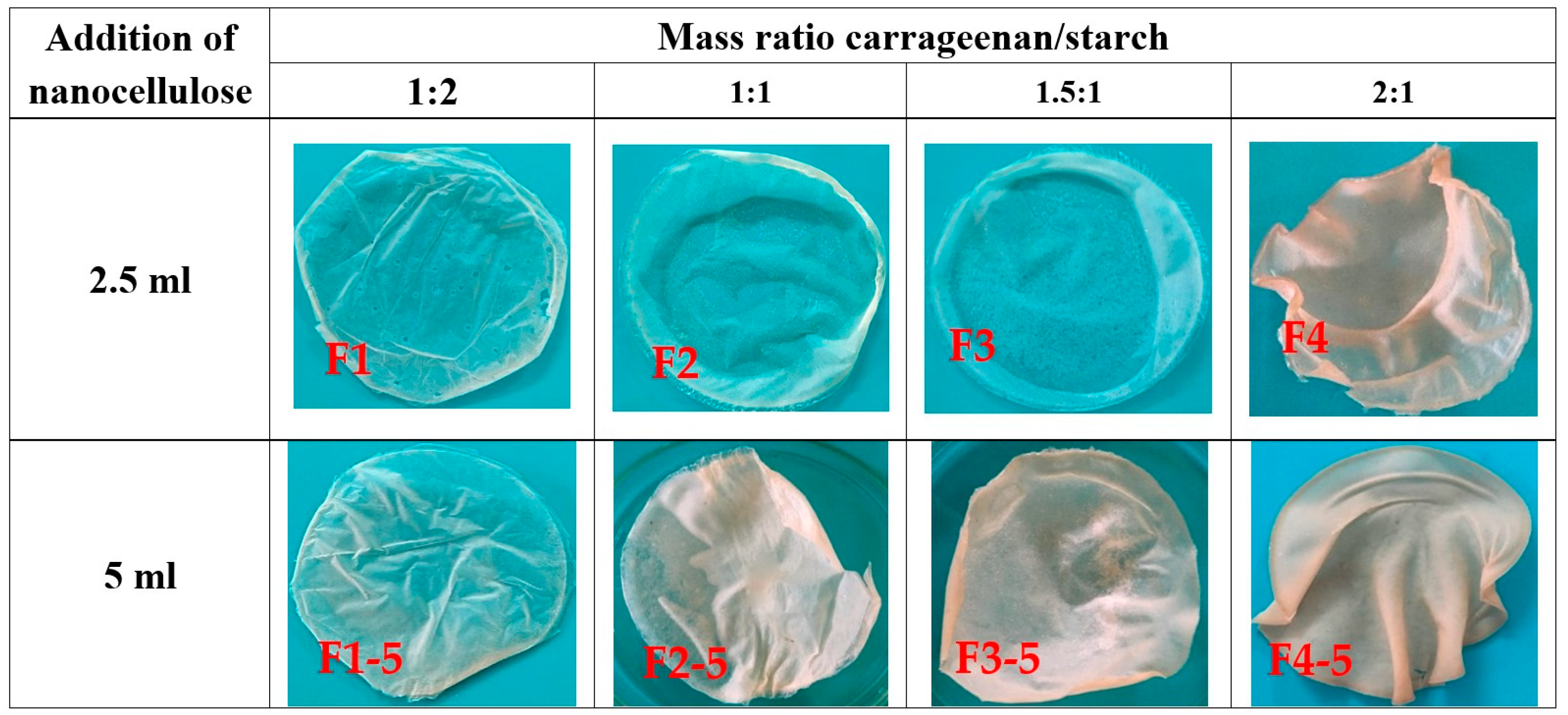
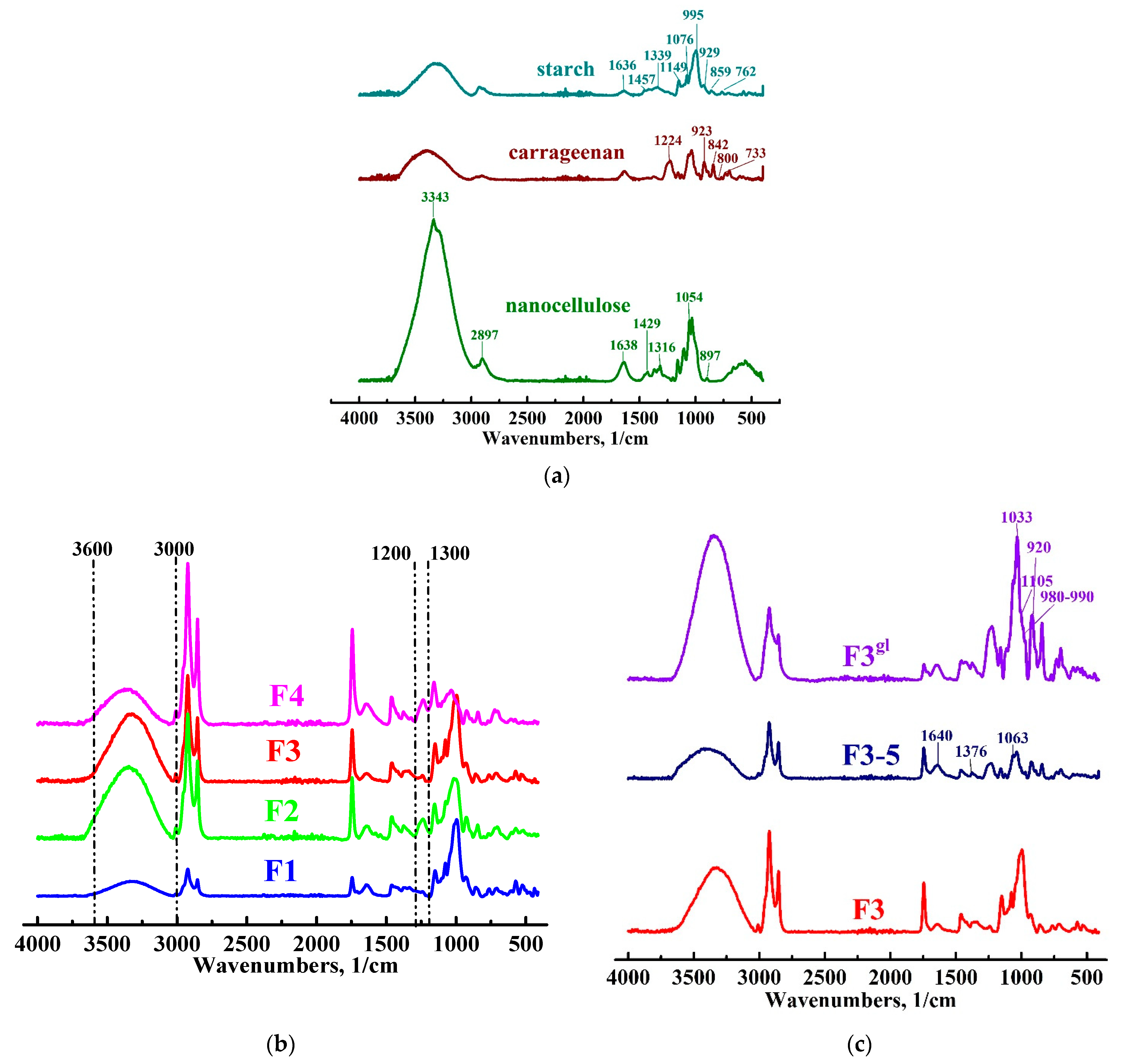
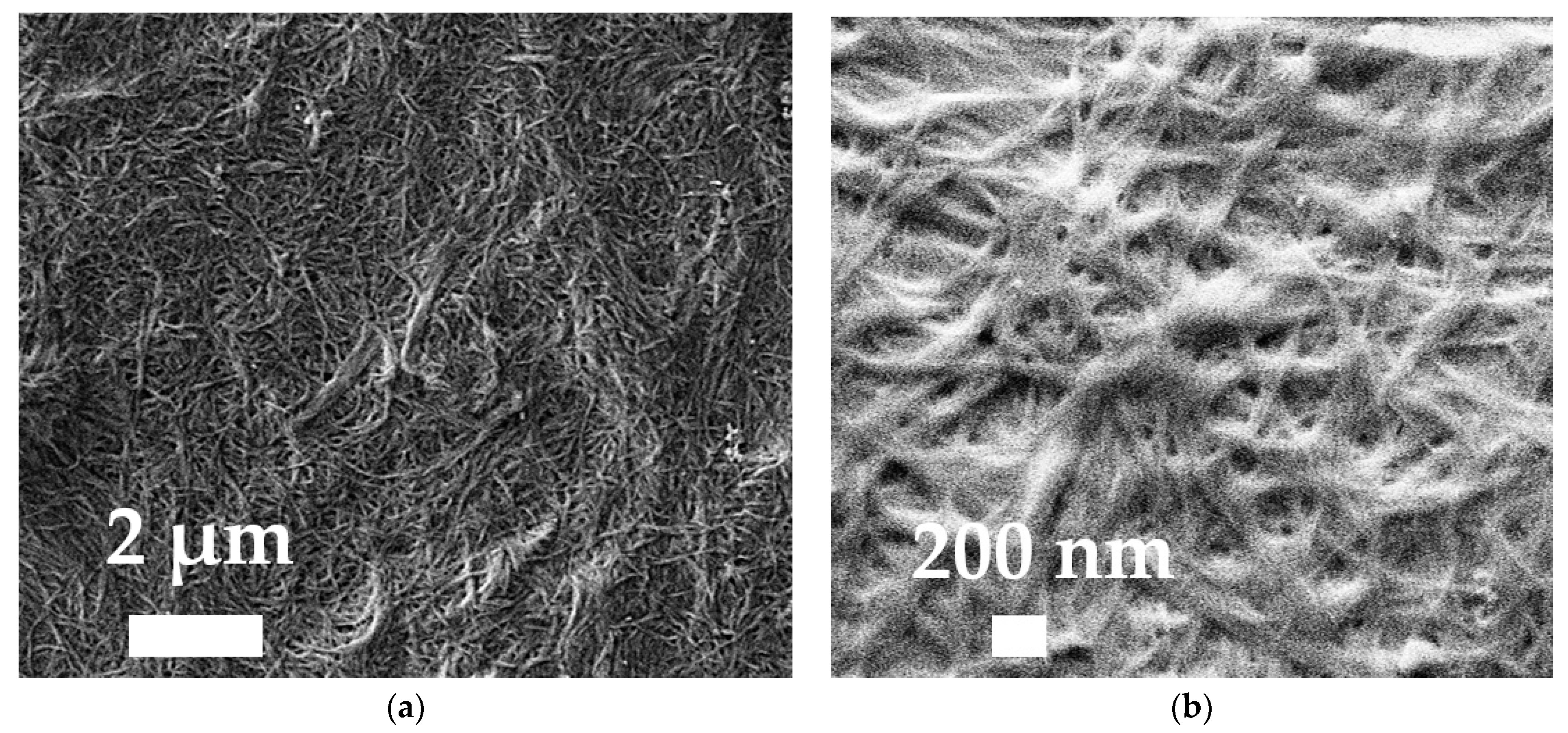

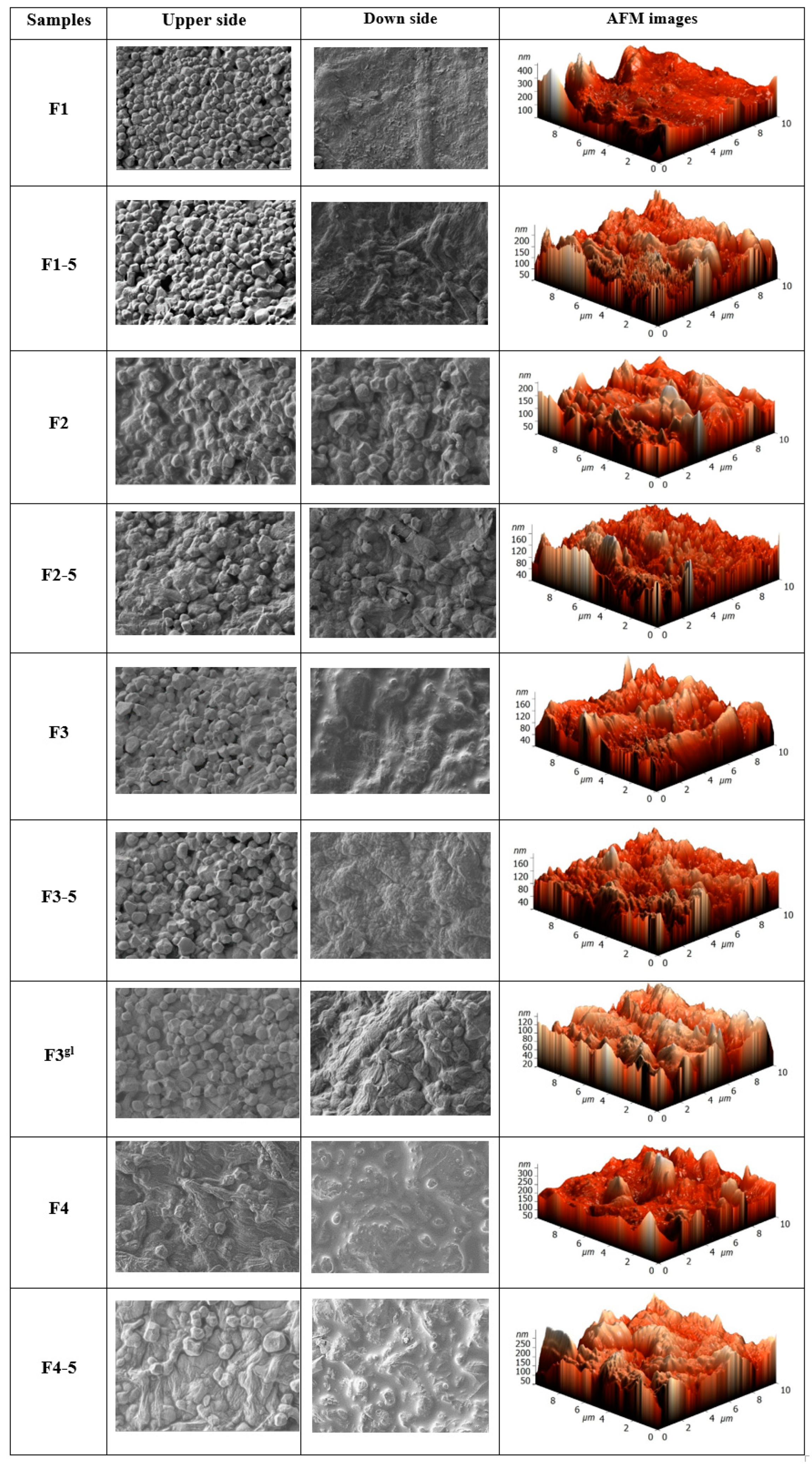
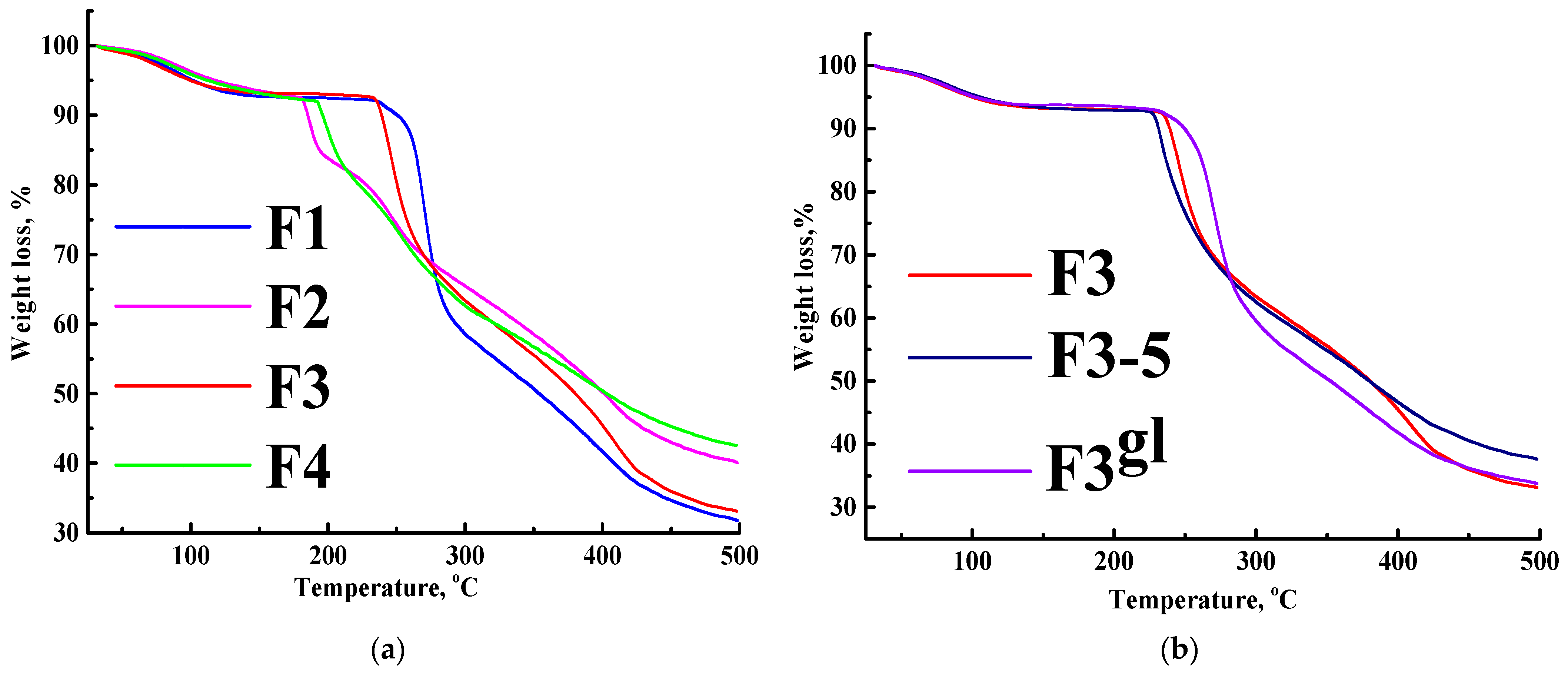

| Designation of Films | Mass Ratio of Carrageenan/Starch | Volume of Aloe Vera, mL | Volume of Nanocellulose, mL | Volume of Glycerol, mL |
|---|---|---|---|---|
| F1 | 1:2 | 2 | 2.5 | - |
| F1-5 | 1:2 | 2 | 5 | - |
| F2 | 1:1 | 2 | 2.5 | - |
| F2-5 | 1:1 | 2 | 5 | - |
| F3 | 1.5:1 | 2 | 2.5 | - |
| F3-5 | 1.5:1 | 2 | 5 | - |
| F3gl | 1.5:1 | 2 | 2.5 | 0.5 |
| F4 | 2:1 | 2 | 2.5 | - |
| F4-5 | 2:1 | 2 | 5 | - |
| Samples | Surface Roughness Parameters | |
|---|---|---|
| Ra, nm | Rq, nm | |
| F1 | 30.4 ± 5.0 | 43.7 ± 8.4 |
| F1-5 | 27.2 ± 3.7 | 34.5 ± 5.6 |
| F2 | 18.9 ± 2.6 | 25.7 ± 4.2 |
| F2-5 | 19.1 ± 3.0 | 24.1 ± 3.9 |
| F3 | 18.1 ± 2.5 | 23.7 ± 3.3 |
| F3-5 | 16.6 ± 2.0 | 20.9 ± 2.9 |
| F3gl | 12.3 ± 1.8 | 15.7 ± 2.4 |
| F4 | 25.3 ± 3.5 | 35.7 ± 6.5 |
| F4-5 | 24.9 ± 3.1 | 33.3 ± 6.0 |
| Samples | Mechanical Properties | Water Contact Angle, ° | |
|---|---|---|---|
| Maximum Tension, MPa | Maximum Elongation, mm | ||
| F1 | - | - | 38 ± 3 |
| F1-5 | 0.65 ± 0.23 | 5.97 ± 2.20 | 35 ± 3 |
| F2 | 0.08 ± 0.04 | 2.37 ± 1.19 | 63 ± 3 |
| F2-5 | 1.54 ± 0.70 | 4.04 ± 1.85 | 58 ± 3 |
| F3 | 0.59 ± 0.29 | 4.89 ± 2.41 | 74 ± 3 |
| F3-5 | 2.70 ± 1.32 | 3.85 ± 1.85 | 73 ± 3 |
| F3gl | 5.64 ± 2.34 | 4.62 ± 1.89 | 71 ± 3 |
| F4 | 0.79 ± 0.35 | 5.15 ± 2.28 | 76 ± 3 |
| F4-5 | 4.69 ± 1.91 | 2.72 ± 1.11 | 74 ± 3 |
| Samples | Thickness, µm | Density, g/cm3 | WVP, g/(s × m × Pa) | OP, % | Sw, % | MA, % |
|---|---|---|---|---|---|---|
| F3gl | 150 ± 10 | 1.34 ± 0.02 | 6.4 × 10−10 | 2.0 ± 0.5 | 42 ± 10 | 29 ± 4 |
Disclaimer/Publisher’s Note: The statements, opinions and data contained in all publications are solely those of the individual author(s) and contributor(s) and not of MDPI and/or the editor(s). MDPI and/or the editor(s) disclaim responsibility for any injury to people or property resulting from any ideas, methods, instructions or products referred to in the content. |
© 2023 by the authors. Licensee MDPI, Basel, Switzerland. This article is an open access article distributed under the terms and conditions of the Creative Commons Attribution (CC BY) license (https://creativecommons.org/licenses/by/4.0/).
Share and Cite
Dmitrenko, M.; Kuzminova, A.; Cherian, R.M.; Joshy, K.S.; Pasquini, D.; John, M.J.; Hato, M.J.; Thomas, S.; Penkova, A. Edible Carrageenan Films Reinforced with Starch and Nanocellulose: Development and Characterization. Sustainability 2023, 15, 15817. https://doi.org/10.3390/su152215817
Dmitrenko M, Kuzminova A, Cherian RM, Joshy KS, Pasquini D, John MJ, Hato MJ, Thomas S, Penkova A. Edible Carrageenan Films Reinforced with Starch and Nanocellulose: Development and Characterization. Sustainability. 2023; 15(22):15817. https://doi.org/10.3390/su152215817
Chicago/Turabian StyleDmitrenko, Mariia, Anna Kuzminova, Reeba Mary Cherian, K. S. Joshy, Daniel Pasquini, Maya Jacob John, Mpitloane J. Hato, Sabu Thomas, and Anastasia Penkova. 2023. "Edible Carrageenan Films Reinforced with Starch and Nanocellulose: Development and Characterization" Sustainability 15, no. 22: 15817. https://doi.org/10.3390/su152215817
APA StyleDmitrenko, M., Kuzminova, A., Cherian, R. M., Joshy, K. S., Pasquini, D., John, M. J., Hato, M. J., Thomas, S., & Penkova, A. (2023). Edible Carrageenan Films Reinforced with Starch and Nanocellulose: Development and Characterization. Sustainability, 15(22), 15817. https://doi.org/10.3390/su152215817












